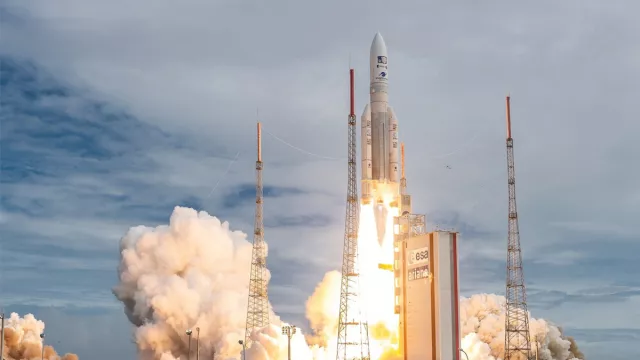Ariane 5 was, in 2023, the latest in the series of launchers that began operating in the late 1970s to give Europe its own independent space launch capability. To keep pace with the trend towards ever-larger satellites, it was designed with double the lift capacity of its predecessor Ariane 4.
Key information
| Mission | Dual launch of geostationary satellites, space probes and other platforms |
|---|---|
| Domain | Space transportation |
| First launch | 4 June 1996 |
| Partners | ESA, ArianeGroup, Arianespace |
| Launch base | Guiana Space Centre |
| Service lifetime | 27 years |
| Status | Completed |
Key figures
- 117 Ariane 5 launches, 5 failures
- 780 tonnes at lift-off
- 55 m high
- 15,120 kN of thrust at lift-off
Key milestones
- 5 July 2023: Last Ariane 5 flight
- 9 March 2008: First Ariane 5 ES flight
- 11 August 2005: First Ariane 5 GS flight
- 2 March 2004: First Ariane 5 G+ flight
- 11 December 2002: First Ariane 5 ECA flight
- 10 December 1999: First Ariane 5 G flight
- 15 June 1996: First Ariane 5 flight
- 31 July 1973: Ariane programme kick-off
Project in brief
The Ariane 5 heavy-lift launcher had assured Europe’s access to space since 1997, quickly establishing itself as the world leader in the launch market for geostationary telecommunications satellites, with the ability to place 10 tonnes for a dual launch and 10.8 tonnes for a single launch into geostationary transfer orbit. It also had the capacity to loft 21 tonnes into low Earth orbit, as it did for the ATV cargo spacecraft that ferried supplies to the International Space Station (ISS).
Ariane 5 was an evolutionary launcher, with five variants built over two decades to accommodate increasingly heavier satellites and meet the needs of institutional and commercial customers. The last commercially operated variant was Ariane 5 ECA.
As of July 2023, Ariane 5 had accomplished 117 launches, with a straight run of 84 successes all variants included, making it one of the most reliable launchers in the world.
Ariane 5 was operated from the Guiana Space Centre in Kourou, alongside the Vega and Vega-C light launchers. Ariane 5 is set to be replaced by Ariane 6, a cheaper, even more powerful and versatile vehicle scheduled to make its maiden flight on 9 July 2024.
CNES’s role
Up to 2007, CNES was prime contractor on behalf of the European Space Agency (ESA).
Launch operations and preparations were performed at the Guiana Space Centre (CSG) north-west of Kourou. The facility belongs to CNES, which manages it as operator for ESA.
Through its Launch Vehicles Directorate (DLA, now the Directorate of Space Transportation or DTS), CNES was in charge of managing all technical and financial aspects of the programme, and responsible for qualifying the launcher. After 2005, the restructuring of the space sector led the agency to provide closer oversight support to ESA. Integrated ESA/CNES teams were set up to oversee the programme’s manufacturers.
DTS teams provided their expertise in:
• Engineering
• Project management
• Management control
• Contract management
• Quality assurance and RAMS (reliability, availability, maintainability, safety)
DTS teams are also responsible for guaranteeing the safety of people and property under the French Space Operations Act (FSOA).
Contacts
Head of Space Transportation Strategy
Philippe Pujes
E-mail: philippe.pujes at cnes.fr


